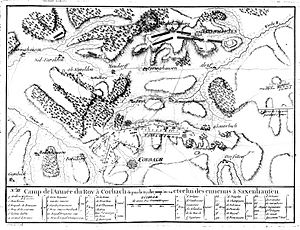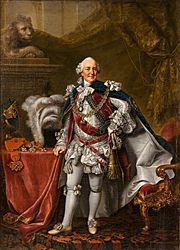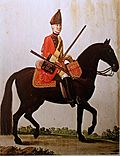Battle of Corbach facts for kids
Quick facts for kids Battle of Corbach |
|||||||
|---|---|---|---|---|---|---|---|
| Part of the Seven Years' War | |||||||
 Camp of the King 's Army at Corbach and that of the enemies at Saxenhausen . |
|||||||
|
|||||||
| Belligerents | |||||||
(or Hesse-Cassel) |
|||||||
| Commanders and leaders | |||||||
| Duke Ferdinand of Brunswick-Wolfenbüttel |
Victor-François, 2nd duc de Broglie Jean-Baptiste Donatien de Vimeur, comte de Rochambeau |
||||||
| Strength | |||||||
|
15,000 to 20,000:
|
7,000 to 12,000: initially, rising to 20,000 1000 to 1200 cavalry 24 Guns |
||||||
| Casualties and losses | |||||||
| 800 to 1,000 dead, wounded or captured 18 guns lost |
700 to 800 | ||||||
The Battle of Corbach was an important fight during the Seven Years' War. It happened on July 10, 1760, near the town of Korbach in what is now Germany. This battle was the first big fight of the 1760 war season. The French army won against the combined forces of Hanover, Britain, and their allies.
Contents
Getting Ready for Battle
The town of Corbach sits on high ground, about 400 meters (1,300 feet) above the flat land around it. This made it a good place to defend. The main French army, led by Victor-François, 2nd duc de Broglie, was about 18 miles (29 km) south of Corbach. The main allied army, led by Ferdinand, Duke of Brunswick, was about 6 miles (10 km) to the east.
General de Broglie wanted to move his army north through Hesse to reach Hanover. Corbach was a key spot on this path.
Capturing Corbach
On July 9, a day before the main battle, a small group of allied soldiers tried to take Corbach. This group was led by General Nicolas Luckner, who commanded light cavalry from Hanover. His force included four squadrons of cavalry and a battalion of Hessian Jägers (light infantry).
However, early on July 10, the first part of the French army, led by General St. Germain, quickly drove Luckner's small force out of Corbach.
Allied Plan to Retake Corbach
When Duke Ferdinand heard about this, he sent his nephew, Karl Wilhelm Ferdinand, who was the Hereditary Prince of Brunswick, to retake Corbach. The Prince's mission was to defeat St. Germain's troops and stop two French armies from joining up there.
The Hereditary Prince's force was a mix of British, Hanoverian, Hessian, and other soldiers. He left Lord Granby in charge of the main allied army and marched towards Corbach. By nine in the morning, his troops were in front of the high ground near Corbach.
The Armies Gather
The British part of the allied force included at least four groups of infantry soldiers (battalions). These were Hodgson's 5th, Cornwallis' 24th, Carr's 50th, and Brudenell's 51st regiments. They also had five groups of cavalry (squadrons), including three from Bland's Dragoons and two from Howard's. A group of 18 cannons, led by Captain Charlton, also joined them.
The rest of the allied army had about nineteen battalions of Hanoverian, Hessian, and Brunswick infantry. They also had fourteen squadrons of cavalry. General Luckner's small force was still nearby, ready to help.
The French force under St. Germain started with two brigades (large groups) of soldiers, de la Tour-du-Pin and la Couronne. Later, they were joined by more brigades, Royal-Suédois and de Castella (which included three Swiss regiments), and then Navarre and du Roi. The size of St. Germain's force changed, but it was likely between 7,000 and 10,000 soldiers, with many cavalry and cannons.
The Battle Begins
General St. Germain placed four groups of his infantry soldiers inside the town of Corbach. The rest of his army, including infantry, cannons, and cavalry, lined up on the high ground of Corbach. This line stretched east and a bit north towards the woods of Berndorf, where he also placed some light troops.
The Hereditary Prince's allied army arrived at 9 AM and attacked right away. However, the way the French were set up meant that the Prince's left side was open. This left them vulnerable if more French soldiers came from Frankenberg.
The battle started with some light cavalry (Hussars) from both sides fighting. Then, a heavy cannon fire began and lasted all day. The infantry also fired their guns fiercely, but the French held their ground. The fighting became very intense in the middle, in a dip between two woods on the hill. Here, the French caused a lot of trouble for the German allied soldiers.
According to a report from Lord Granby, more French troops arrived from Frankenberg and attacked the allied army from behind. This forced the Hereditary Prince to decide to pull his troops back.
The Retreat
As the allied German infantry and cavalry began to retreat, confusion broke out. The French fired their cannons even faster and charged with a large group of cavalry. The allied retreat started around 3 in the afternoon and was quite messy.
Two British cavalry groups, the 1st King's Regiment of Dragoon Guards and the 2nd Queen's Regiment of Dragoon Guards, led by the Hereditary Prince himself, charged forward. They are given credit for saving almost the entire allied force from being completely defeated. The 1st KDG lost 47 soldiers in this brave charge.
These two British cavalry regiments and two British infantry regiments (the 50th and 51st) covered the retreat of the allied soldiers. However, they could not stop the French from capturing the allied cannons and 18 guns.
What Happened Next
The Battle of Corbach was the first major battle of the 1760 fighting season. The French victory at Corbach, along with de Broglie's early moves, helped them keep moving forward and gain ground in Germany.
Even though the Hereditary Prince and Ferdinand won some later battles, like Emsdorf and Warburg, the French success at Corbach was important. Later in October, the French had another small victory at the Kloster Kampen. This meant that any hope the British had of ending the war on good terms in 1760 disappeared, even though they had won battles in America.




